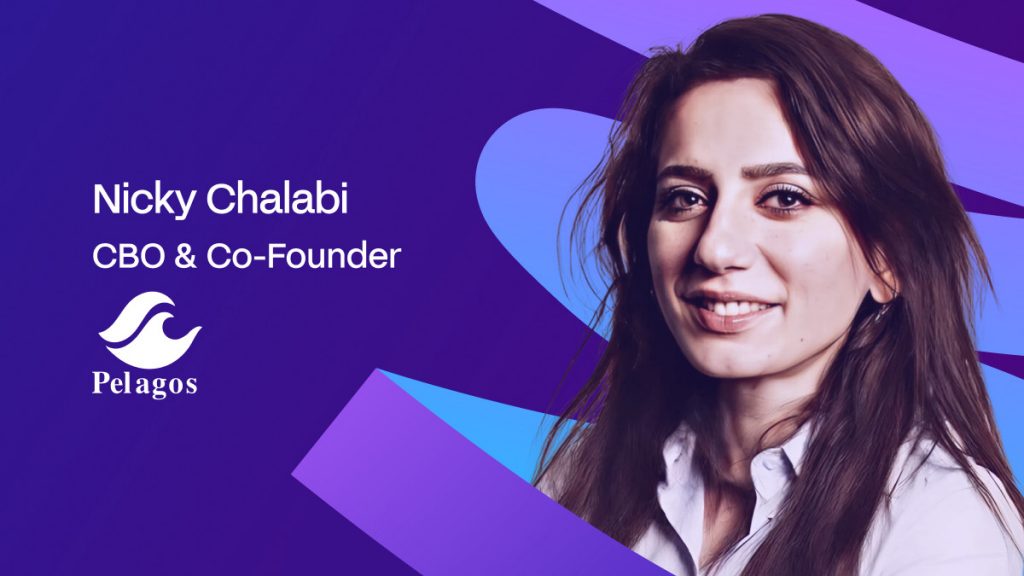Pelagos is Turning One Click Into Multi-Chain Execution


In Brief
Pelagos is redefining blockchain interoperability by enabling one-click, atomic execution across multiple chains — no bridges, no friction, just seamless multi-chain transactions.

Nicky Chalabi’s journey into Web3 began with a cold LinkedIn message to a crypto exchange in Switzerland, a bold move that kickstarted her career in the blockchain industry in 2017. Today, as CBO and Co-Founder of Pelagos, she is helping to redefine how blockchains communicate. In this interview, Nicky explains how Pelagos aims to eliminate the need for bridges entirely, creating a seamless multi-chain execution layer where transactions happen everywhere or nowhere at all.
Could you please introduce yourself and tell us about your path into Web3?
My name is Nicky, and I have been working in this space since 2017. My path into Web3 began during the ICO boom around 2016 and 2017. I found it fascinating that you could read white papers, invest in projects, and join Telegram groups to ask founders questions directly. It suddenly made innovation accessible to regular people without the traditional investment barriers.
In 2017, I joined a centralized crypto exchange in Switzerland called Lykke. I actually found them on LinkedIn, sent a message, and they invited me for a chat. That was how I started working there, and that was my entry point into Web3.
Since then, I have never left the space. I went through all the ups and downs. The 2018-2019 downturn was quite dramatic compared to 2022, because the industry was much smaller back then. Over the years, I have worked for several projects and solution providers, including NEAR, Neon, Telos, and Taiko.
I met the founders of Pelagos, Evgeniy and Boris, a few years ago through a friend who has been in space for a long time. We first met in 2018. I knew they were building something interesting, and I was always chatting and discussing ideas with them. At that time, they were still on DevNet and trying to gather data to prove that their solution worked. They had been building it since around 2021, during the COVID days.
After some time, when the solution became more mature and they had results from DevNet, they wanted to take it further and raise funds. That is when we decided that I could join as a business co-founder, and that is how Pelagos was born.
What is Pelagos’s mission and long-term vision in the multi-chain infrastructure space?
Pelagos creates what I would call a singularity in the multi-chain space that has long been missing. It enables one decision, one event horizon, and native transaction execution everywhere or nothing at all. If you look at the space, many are trying to fix cross-chain issues by building better bridges, smarter routers, or intent frameworks.
In practice, most cross-chain actions still rely on separate attempts and guesses. One venue fills while another lags, quotes drift, partial refunds occur, and reconciliation is needed. The current cross-chain infrastructure is not scalable. It has been patched for years with bridges and routers, but there is no true execution layer. Everyone is guessing first and reconciling later.
Cross-chain does not need a better route or belief system. It needs a single global decision point. Either everything happens exactly as planned or nothing happens at all.
Pelagos turns that idea into a product. It acts as an execution layer for crypto. You sign once, Pelagos simulates the entire path across chains, including prices, liquidity, gas, timing, and policy. If everything fits the constraints, Pelagos consigns the native transactions on-chain and releases them together. If any check fails, nothing is broadcast.
The result is a deterministic, fast, and verifiable experience without visible bridges or trust assumptions. It produces a single auditable outcome. We believe this approach wins for several reasons. Fragmentation is permanent, and liquidity and users are spread across many chains. Serious systems must coordinate across them without relying on luck. Automation is rising, and institutions require deterministic outcomes.
Compliance also matters. Institutions have policies, KYC and KYB processes, and policies that must be respected. Pelagos accepts the market as it is, messy and multi-chain, and makes it safe to act. The breakthrough is not another bridge but a single decision point in front of everything. Routing and options then become implementation details.
The crypto space does not lack ideas or capital. It lacks a way to press one button and know. When confidence exists, complex operations become simple. Pelagos represents the moment when the industry stops pretending to be cross-chain through patches and starts executing through a single enforceable promise. Our mission is to make cross-chain operations as seamless as possible.
What major milestones has Pelagos achieved so far, and what are the next key milestones you are targeting?
Since early 2024, we have been on devnet, and during that time we achieved several performance benchmarks. Free AWS credits were awarded from EF to Pelagos. Our developers have also worked with projects such as Polygon, Ethereum Foundation, and Fantom.
Since August, we have been focused on releasing our SDK to allow developers to build on Pelagos. We released the SDK in September and already have several teams deploying, including LiquidMarkets, which launched a unified order book on Pelagos, LayerCover, which is deploying an insurance protocol, Dodo, which is bringing its existing solution onto Pelagos, and Predictive, which is building a resolution marketplace.
Recently, we also announced that Solana is available on Pelagos. Developers can now read and write to SVM, perform cross-chain swaps between SVM and EVM, and access liquidity from any EVM network. Next, we are releasing a permissioned testnet so people can experiment while we maintain quality control.
We are also preparing validator documentation and infrastructure. Initially, validator onboarding will be permissioned so we can ensure proper integration before moving to a permissionless model.
Our next goals include launching the staging testnet, performing infrastructure and consensus audits in Q2 2026, releasing the Rust SDK, and focusing on mainnet launch and partner migration in Q3 2026.
How do you ensure interoperability and compatibility across different blockchains?
The concept is actually simple. Every smart contract and chain acts as one seamless network. You can trade across Ethereum, Solana, BNB, Arbitrum, and Rust as if it were a single chain. Pelagos unifies on-chain state and execution.
A user or app sends one transaction. The system simulates it in the background, validators sign using threshold signatures, and if everything is correct, the transaction is committed atomically across chains. If any part fails, nothing moves.
From a technical perspective, we have a leaderless consensus stack that effectively makes us a chain as well, though the end user does not see Pelagos directly. We use reactive multi-chain inputs and outputs, co-sign unbound transactions using TSS, and run dockerized app chains that serve as their own execution environments. This allows developers to define their own logic, VM, and language.
What key partners or alliances have you already secured, and which sectors are targeted next?
We are working with several dApp builders. Liquid Markets is building a cross-chain order book. LayerCover is developing an insurance protocol. Predictive is building a resolution marketplace. We are also collaborating with Dodo, a well-known DEX. In addition, we are working closely with the Avail team.
What market trends or shifts do you see as the biggest opportunities or threats, such as interoperability, Layer 1s, or DeFi regulation?
I don’t see anything as a threat — every threat creates an opportunity. The biggest challenge is regulatory uncertainty. Regulations can change quickly depending on political shifts, especially in the United States, and the industry still depends heavily on these factors.
In terms of interoperability, most projects now focus on cross-chain messaging protocols, intents, and solvers. We are more complementary than competitive in that area, though I would like to see more solutions like Pelagos emerge.
Regarding Layer 1s and Layer 2s, I believe we will see more purpose-specific networks rather than general-purpose ones, optimized for specific use cases such as payments, stablecoin rails, or trading.
As for DeFi, I was very excited about it during 2020 and 2021 when many innovative projects appeared. Since then, it has become somewhat stagnant, focusing too much on speculation. However, as regulatory frameworks mature, I expect more meaningful applications to emerge, along with better consumer protection and fewer hacks.
Let’s get back to the platform itself. What are the incentives for users, developers, and node operators? What programs or mechanisms do you have or plan to attract and retain usage?
We are focusing on rewarding the community through an ambassador program. Ambassadors have different skills — some are more technical, others focus on community events. They have OKRs and KPIs to meet. I was inspired by Polkadot’s ambassador program, which was very effective in its early days.
We are also planning an accelerator program with partners. Selected projects will build applications using Pelagos’s atomic cross-chain capabilities over a 16-week program, culminating in a demo day with mentors and investors. The program will have different tracks such as DeFi, institutional, RWA, payments, and tooling.
We want to focus more on rewarding real effort and contribution rather than just airdrops. Builders on Pelagos will be encouraged to allocate part of their community treasury to incentivize usage through rebates, exclusive deals, and loyalty programs.
We are moving away from traditional grants because we believe they often do not attract the right builders aligned with the ecosystem’s goals. Instead, we want to support sustainable and motivated development.
How would you define a successful Pelagos over the next three to five years?
Success for Pelagos means that no one thinks about bridges anymore. Users will not need to open a separate interface to bridge assets. They will simply perform actions atomically without caring which chain runs underneath. You send one transaction, and that’s it. That is how I define success for Pelagos.
Disclaimer
In line with the Trust Project guidelines, please note that the information provided on this page is not intended to be and should not be interpreted as legal, tax, investment, financial, or any other form of advice. It is important to only invest what you can afford to lose and to seek independent financial advice if you have any doubts. For further information, we suggest referring to the terms and conditions as well as the help and support pages provided by the issuer or advertiser. MetaversePost is committed to accurate, unbiased reporting, but market conditions are subject to change without notice.
About The Author
Victoria is a writer on a variety of technology topics including Web3.0, AI and cryptocurrencies. Her extensive experience allows her to write insightful articles for the wider audience.
More articles

Victoria is a writer on a variety of technology topics including Web3.0, AI and cryptocurrencies. Her extensive experience allows her to write insightful articles for the wider audience.

















































